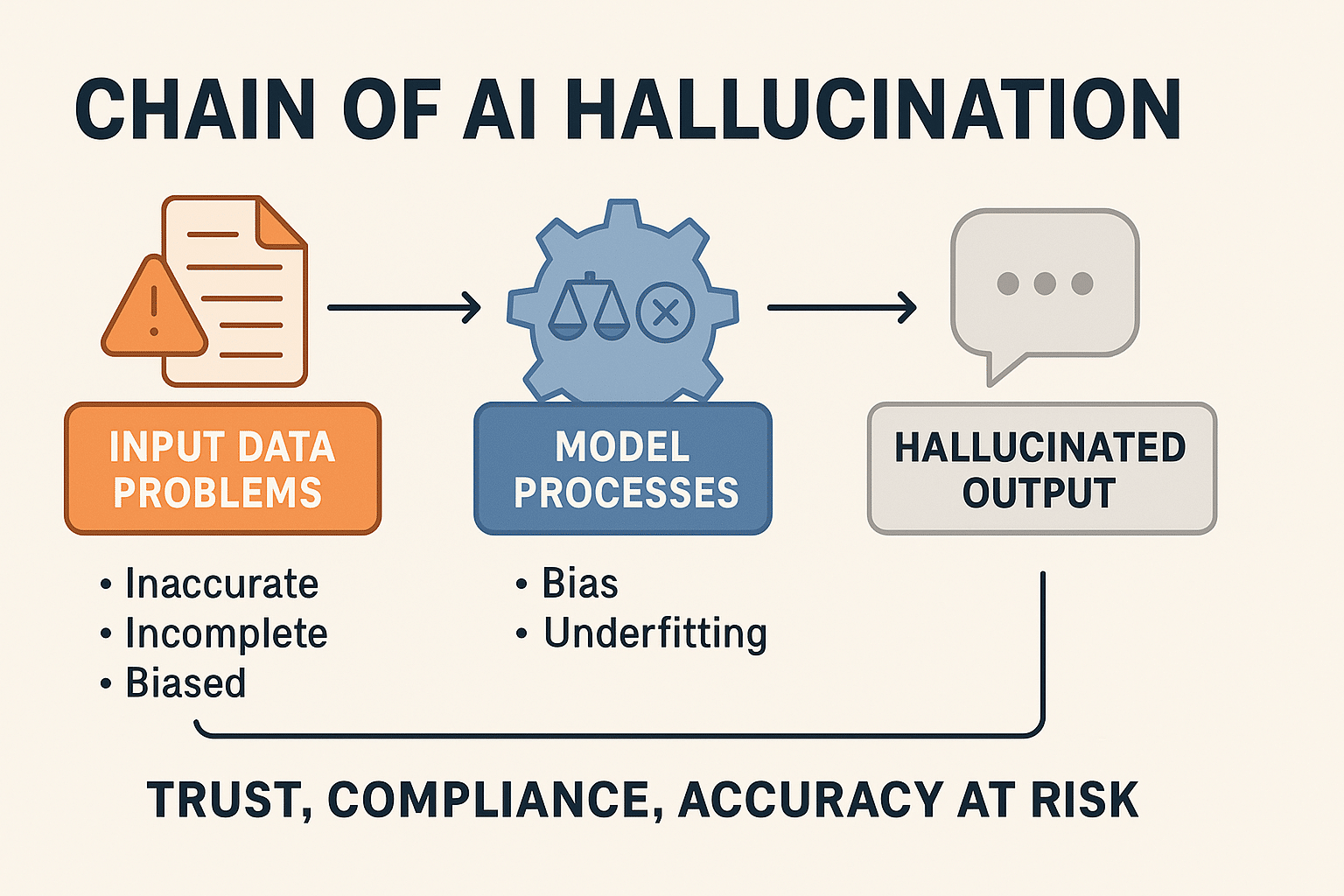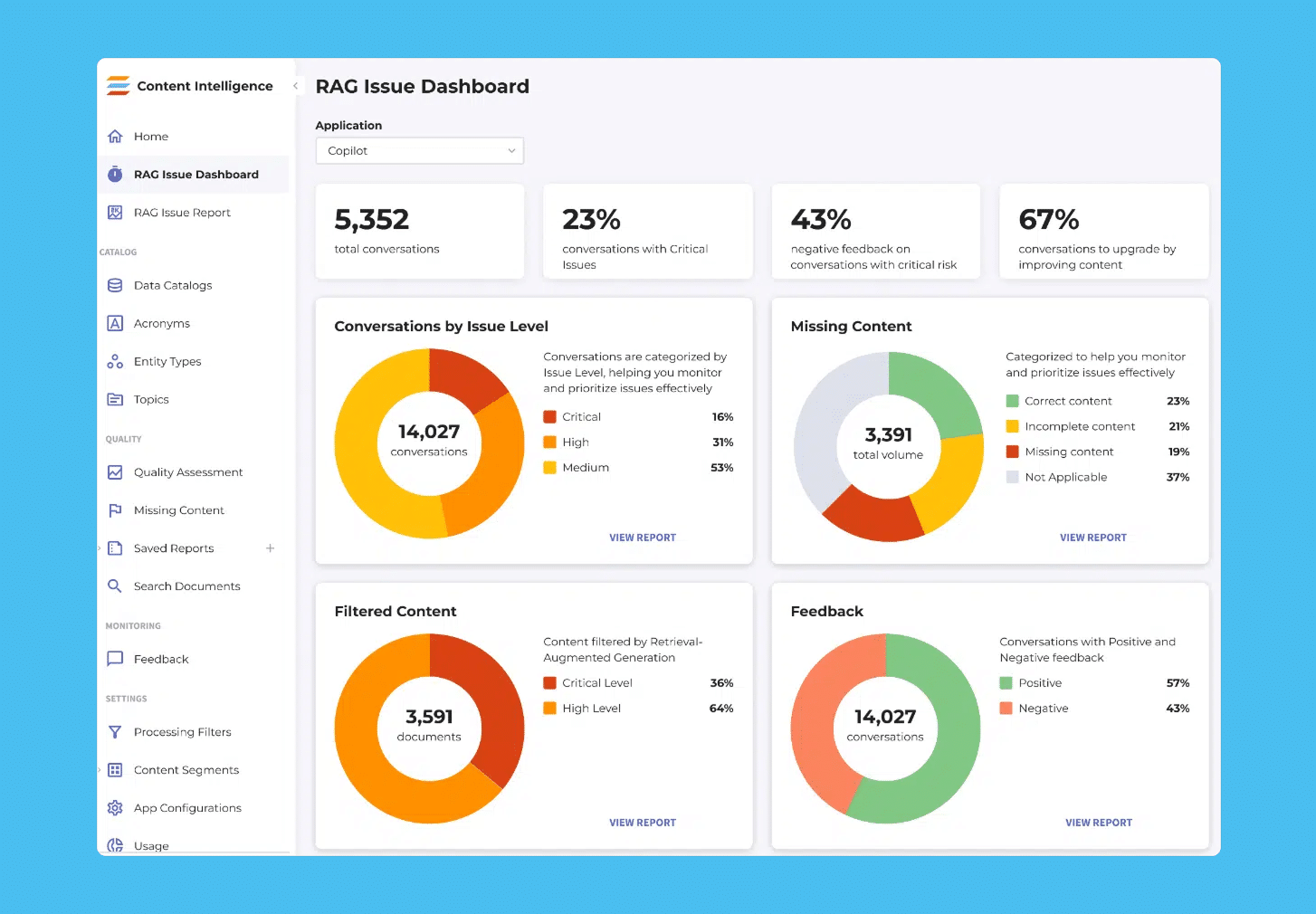AI models don’t think—they predict. When they generate false or misleading outputs, it’s because they’re filling in gaps based on patterns in their training data.
This phenomenon, known as AI hallucination, leads to responses that sound correct but have no basis in reality. For AI leaders and tech executives, these errors undermine trust, create compliance risks, and reduce the reliability of your GenAI applications.
To stop AI hallucinations, you need a structured approach that improves data quality, refines model behavior, and enforces strict validation methods. This guide explores the reasons hallucinations happen and provides actionable strategies to help you build more reliable AI systems.
What is AI Hallucination?
AI hallucination refers to instances when an AI model produces outputs that are technically plausible but factually incorrect or unsupported by its training data. The data appears coherent but lacks a reliable basis in reality. The error stems from how the model uses statistical patterns to predict text, rather than a true understanding of information.
The issue arises from the quality of the input data. Incomplete or biased training datasets force the model to fill in gaps. This can lead to hallucinated content that seems valid on the surface but falls apart under scrutiny because the underlying algorithms optimize for language fluency, not factual accuracy.
If you want users to trust your GenAI solutions, you must minimize hallucinations. You need to identify when the model deviates from reality and implement checks and balances that ensure the outputs align with verifiable sources.

Why Do AI Hallucinations Happen?
Before we talk about minimizing hallucinations, it’s important to understand why they happen in the first place. Here are the primary causes.
Poor Training Input
Poor data is the primary cause of AI hallucinations. When your training input is flawed, the model struggles to learn an accurate representation of reality. You risk generating outputs that contain errors or fabrications. What makes data poor?
- Inaccurate Data: The model learns from data that contains errors.
- Incomplete Data: Missing information forces the model to fill gaps on its own.
- Outdated Data: Data that no longer reflects the current state of affairs so the model may provide responses that are no longer relevant.
- Biased Data: Training data with bias skews the model’s understanding, which results in outputs that favor certain perspectives over others.
- Irrelevant Data: Including data that does not pertain to your target context confuses the model.
- Misleading Data: Data that is purposely or inadvertently misleading can drive the model toward incorrect conclusions.
- Duplicated Data: Repetition in your training set can overemphasize certain facts.
- Poorly Structured Data: Disorganized data makes it difficult for the model to learn clear patterns.
Each of these issues forces the model to work with suboptimal information, thereby increasing the likelihood of generating false or unreliable outputs. You must ensure that your training data is clean, current, and relevant to reduce the risk of hallucinations.
Poor Model Design
You might see hallucinations when the model’s design lacks the proper architecture. If you build the model without enough complexity or fail to capture important context, it can generate outputs that stray from the facts.
Overfitting and Underfitting
When you overfit a model, it clings too closely to its training data. It might generate content that works in specific contexts but fails in broader scenarios. Underfitting means the model doesn’t capture enough detail. Both cases lead to unreliable outputs. You must strike a balance to reduce hallucinations.
Algorithmic Bias
Bias in algorithms plays a role in why hallucinations occur. If your model is influenced by biased patterns from its training data, it may produce skewed or incorrect information. Recognizing and correcting these biases is challenging, but an important part of keeping your models accurate.
Inadequate Training
If your training data is incomplete or lacks diversity, the model has gaps in its knowledge. You might see hallucinations as the system tries to fill in these gaps with assumptions. High-quality and comprehensive training data helps you mitigate this risk.
Hardware Limitations
The performance of your model can suffer when hardware constraints limit its capacity. Inadequate processing power or memory might force the model to simplify outputs, which can lead to hallucinations.
Environmental Changes
Models are sensitive to the context in which they operate. When the environment shifts (be it new topics or unforeseen scenarios) the model may generate errors. Staying aware of the operating environment helps you adapt the model and minimize hallucinations.
For instance, suppose new financial regulations are put in place. Models that aren’t trained on the new regulations will operate under the old framework, and ultimately provide answers that don’t make any sense.
Poor Data Integration
If you struggle to combine structured and unstructured data, your model might produce inaccurate results. Misaligned datasets can lead to outputs that don’t match reality.
How Shelf Helps You Fight Hallucinations
Shelf helps your AI generate accurate, fact-based responses by grounding it in real, verified knowledge. Instead of relying on static training data, Shelf uses retrieval-augmented generation (RAG) and semantic search to pull information from trusted, structured sources in real time. This prevents AI from filling in gaps with assumptions, reducing the risk of hallucinations.
Shelf also fights the effects of outdated information by continuously syncing with your latest company data so AI always references the most current and relevant sources. Through automated content ingestion, intelligent tagging, and schema validation, Shelf keeps AI responses accurate and aligned with your organization’s knowledge base.

How to Stop Your AI from Hallucinating
Stopping AI hallucinations requires a multi-layered approach. You need to combine multiple techniques and safeguards to reduce false outputs. The following strategies help you minimize hallucinations and improve model accuracy.
Step 1: Use High-Quality Training Data
You must begin with high-quality training data to limit AI hallucinations. The model’s accuracy is directly tied to the integrity of its input data. You need datasets that are thoroughly vetted, correctly annotated, and aligned with your target domain.
You can employ TensorFlow Data Validation (TFDV) to perform statistical analysis on your datasets. This tool helps you detect anomalies, missing values, and schema deviations.
Apache Spark also offers robust data processing capabilities. It can handle large volumes of data and identify discrepancies that might lead to erroneous model behavior.
Frameworks like TensorFlow Extended (TFX) allow you to build end-to-end data pipelines. With TFX, you can automate data ingestion, transformation, and validation. These pipelines enforce strict schema consistency so that only high-quality data enters the training process. MLflow can also be integrated to track experiments and monitor data quality over multiple iterations.
Step 2: Define a Clear Purpose for Your AI Model
Before training your AI, you need to define its exact purpose. A model trained without clear scope is more likely to generate misleading outputs. Specify the problem domain, expected input types, and acceptable error margins. This prevents the model from overgeneralizing or extrapolating beyond its intended function.
You should implement architectural constraints that reinforce this purpose. For instance, if you’re working with natural language models, use fine-tuned transformer architectures like BERT or T5 rather than relying on generic large language models. In computer vision, applying YOLO or EfficientNet for object detection tasks prevents the model from attempting unnecessary classifications.
In addition, you can enforce strict validation metrics during training. Use cross-entropy loss for classification tasks or BLEU/ROUGE scores for NLP models to measure alignment with ground truth data. Frameworks like Weights & Biases or MLflow help track these metrics.
Step 3: Restrict Your Data Set
Overloading your model with unnecessary data increases the risk of hallucinations. You need to curate and restrict the training dataset to only relevant, high-quality data points. Including extraneous or low-confidence data forces the model to make associations that aren’t meaningful to the model’s overall context.
Use TensorFlow Data Validation (TFDV) or Great Expectations to profile and filter your dataset before training. These tools help identify and remove inconsistencies, duplicates, and outliers that could lead to errant model behavior. In Apache Spark, you can leverage MLlib’s feature selection methods to eliminate noisy variables that contribute little to predictive performance.
Dataset restriction should also consider domain-specific constraints. For instance, if you’re building a financial forecasting model, avoid mixing general economic data with social media sentiment unless explicitly validated.
Similarly, in healthcare applications, limit training data to verified clinical sources to prevent misinformation. Entity Recognition (NER) filters in NLP pipelines ensure that only verified entities appear in generated outputs.
Step 4: Be Specific with Your Prompting
When working with AI models, especially LLMs and retrieval-augmented generation (RAG) systems, vague or ambiguous prompts increase the likelihood of hallucinations. You need to craft prompts that provide clear instructions, constraints, and context.
For text-based AI, use structured prompts with explicit guidelines. Instead of asking, “Summarize this article,” specify the required length, key details to include, and the target audience:
Example: “Summarize this research paper in 200 words, focusing on the methodology and findings, for an audience of machine learning engineers.”
For multi-modal AI models, such as those using CLIP (Contrastive Language–Image Pretraining) or DALL·E, prompt engineering involves including domain-specific keywords and constraints. If generating an image of a car for autonomous driving datasets, specify:
Example: “Generate a high-resolution image of a red Tesla Model S, front angle, with lidar sensors visible, under clear daylight conditions.”
In RAG systems, use grounding techniques to minimize hallucinations. Instead of asking a chatbot to answer broadly, force it to cite sources:
Example: “Using only the provided knowledge base, explain the difference between CNNs and RNNs, and cite the source document.”
Frameworks like LangChain and LlamaIndex can help you with structured prompt injection. You can also integrate prompt tuning techniques, using tools like Google’s T5 Prompt Tuning or OpenAI’s Function Calling.
Step 5: Use Data Templates
Standardized data templates reduce variance in model inputs. This makes responses more predictable and reduces hallucinations. You need a structured approach to formatting data before ingestion, whether for training or inference.
For structured data ingestion, use schema enforcement with tools like Apache Avro, JSON Schema, or Protocol Buffers (protobufs) so the model processes inputs consistently. In Pandas, enforce a strict data structure:
import pandas as pd
schema = {
“text”: str,
“category”: str,
“date”: “datetime64[ns]”,
“source”: str
}
df = pd.read_csv(“dataset.csv”, dtype=schema)
For NLP models, you should preprocess text using templates that enforce structure. If you’re training an AI model for customer support, use structured input-output mappings:
Input Template:
Customer Query: {query_text}. Previous Interactions: {interaction_history}. Required Format: {response_structure}
Output Template:
Response: {generated_response}. Confidence Score: {confidence_level}. References: {source_documents}
In RAG-based architectures, enforce strict document embedding formats using FAISS (Facebook AI Similarity Search) or ChromaDB. This ensures that only structured, high-confidence documents contribute to retrieval processes.
Step 6: Test and Refine Continually
Minimizing hallucinations requires continuous testing and refinement. You need a structured approach to evaluating model outputs, identifying failure cases, and iterating on improvements.
Use unit tests and integration tests to validate AI performance. In Hugging Face’s Transformers, you can run model evaluation scripts to benchmark accuracy across different datasets. In PyTorch, use torch.nn.functional.cross_entropy or mean_squared_error to assess classification and regression performance.
For large-scale validation, use automated A/B testing and adversarial testing pipelines. Tools like DeepChecks or Great Expectations can compare model-generated outputs against ground truth data.
You can also automate stress testing by injecting edge-case scenarios into your test set. For retrieval-based models, measure precision@k, recall@k, and MRR (Mean Reciprocal Rank) to ensure high-quality responses.
In production environments, monitor for drift using Evidently AI or Neptune.ai. If the model starts generating inaccurate outputs, retrain it with continual learning strategies using Delta Tuning (LoRA) or adapter layers in LLM fine-tuning frameworks.
Step 7: Leverage Human Oversight
Even the most refined models require human oversight to catch errors AI systems may overlook. You need a human-in-the-loop framework for validation and correction.
For AI-assisted decision-making, use active learning loops to prioritize human review on uncertain cases. In Label Studio or Amazon SageMaker Ground Truth, you can assign human reviewers to validate model predictions. For NLP models, use Reinforcement Learning from Human Feedback with platforms like Anthropic’s Constitutional AI or OpenAI’s feedback mechanisms.
In retrieval-based AI, humans must review your knowledge base updates. Use version-controlled embeddings in FAISS or ChromaDB so that human reviewers can verify which documents contribute to generated responses. In structured applications, enforce confidence scoring thresholds where only responses above a set confidence level bypass human review.




